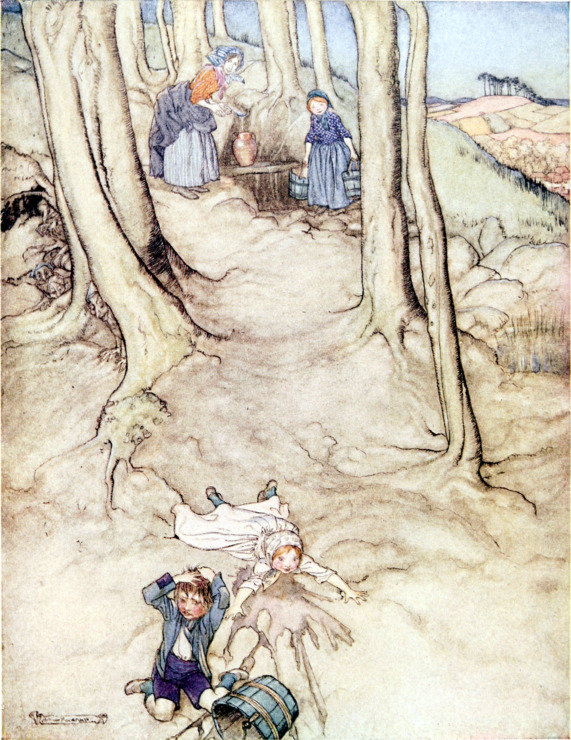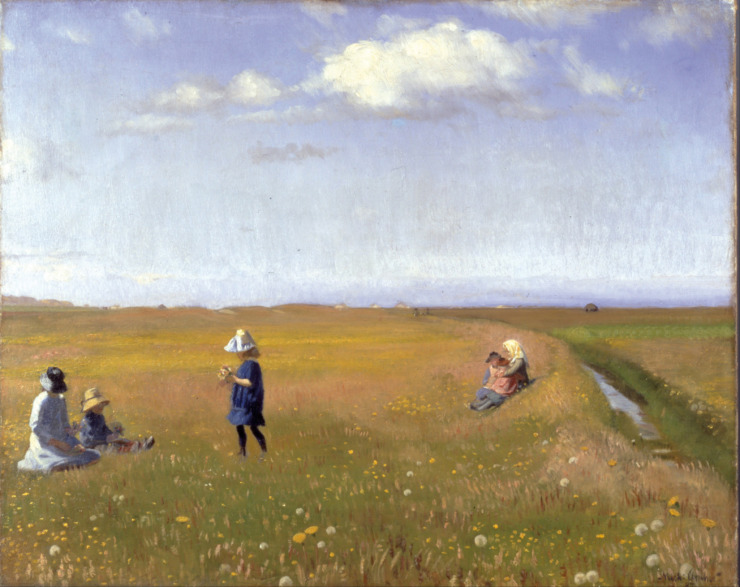Over the Hill and Over the Dale
Over the hill and over the dale,
And over the bourn to Dawlish —
Where gingerbread wives have a scanty sale
And gingerbread nuts are smallish.
Rantipole Betty she ran down a hill
And kicked up her petticoats fairly;
Says I’ll be Jack if you will be Gill —
So she sat on the grass debonairly.
Here’s somebody coming, here’s somebody coming!
Says I ’tis the wind at a parley;
So without any fuss any hawing and humming
She lay on the grass debonairly.
Here’s somebody here and here’s somebody there!
Says I hold your tongue you young Gipsey;
So she held her tongue and lay plump and fair
And dead as a Venus tipsy.
O who wouldn’t hie to Dawlish fair,
O who wouldn’t stop in a Meadow,
O who would not rumple the daisies there
And make the wild fern for a bed do!
-John Keats
Enjoy Artistic Representations of “Over the Hill and Over the Dale” by John Keats

Jack and Jill by Arthur Rackam, 1913.

Michael Ancher – Children and young girls picking flowers in a field north of Skagen, 1887.
Listen to this Reading of “Over the Hill and Over the Dale”
Listen to this Musical Interpretation of “Over the Hill and Over the Dale” by John Keats
John Keats Biography
Keats was born in London on Oct. 31, 1795; a few weeks later he was baptized at St. Botolph Without Bishopsgate Church, near where his parents lived and father worked as the manager of a stable owned by his father-in-law. Keats was the eldest of four children, with George, Tom, and Fanny following him. The family was well off enough that the boys were sent to Clark’s Academy in Edmonton at what is now the north London borough of Enfield for their education; it was riding his horse home from a visit to the school that Keats’ father fell and died the next day. His mother remarried (rather quickly, in fact), fought with the rest of the family, and died fairly young from consumption or tuberculosis, which was all too common at the time and would eventually claim the life of Keats’ youngest brother, Tom, as well as Keats himself.
He was apprenticed to a local doctor, but the relationship didn’t seem to work too well. He ended up working at St. Guy’s Hospital in the Southwark district of London, continuing his medical training and writing poetry (the site of the original St. Guy’s in now occupied by London’s tallest office building, known locally as “The Shard”).
While Keats had numerous city connections (Anita Miller also has a “Keats in the City” walk), it is with Hampstead that he is most closely associated. Fellow poets lived there, as did the editor who first published his poetry. Artists whom Keats associated with lived there. Keats himself would move there with his brothers. Keats and his friends would wander Hampstead Heath, talking and arguing poetry and the issues of the day. After moving into Wentworth House in Hampstead, Keats wrote five of six famous odes, including “Ode to a Nightingale.” And it would be at Wentworth House in Hampstead that Keats would realize that he was dying from the same disease that took his mother and younger brother.
Enjoyed Over the Hill and Over the Dale by John Keats and want to know more about Keats’ life? Try A Month With Keats: A Walk Into His Life
That’s it for Over the Hill and Over the Dale!
BUY ‘HOW TO WRITE A FORM POEM’ NOW!
